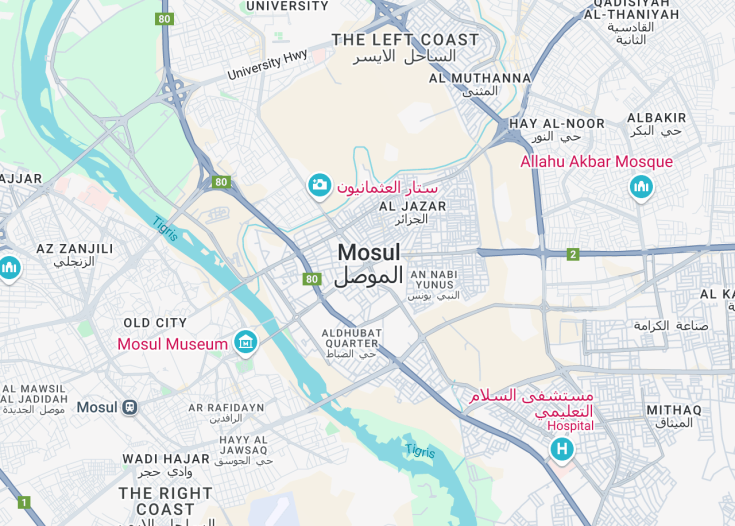Mosul, the historically enchanting city located in northern Iraq, offers a profound glimpse into the past and present of Mesopotamian culture. From the grandiose al-Nuri Mosque to the bustling markets that line its ancient laneways, Mosul is a paradigm of resilience and rebirth. Despite its challenges, including rebuilding from recent conflicts, the city remains a significant cultural hub, with historical sites that display a range of influences from various epochs and civilizations.
Ensure to respect and adhere to local customs and dressing norms to enhance your cultural experience in Mosul.
Prioritize visiting in the cooler months, from October to April, when the climate is more conducive for exploring the rich heritage of the city.
Top things to do & see in Mosul
Select the following sights and activities to discover best tickets and tours available in Mosul.
Mosul: A City Reborn
| Country | Iraq |
| Time in Mosul | GMT+3 |
| Language spoken | Arabic |
| Population | 1.8 million (Source: UN Data, 2022) |
| Currency | Iraqi Dinar (IQD) |
| Airports | Mosul International Airport. |
Mosul, once a pivotal city in the ancient and medieval world due to its strategic position on the trade routes, has witnessed several historical moments spanning from the Assyrian Empire to recent conflicts. Today, Mosul is on a path of recovery, with focuses on rebuilding infrastructure, restoring cultural sites, and revitalizing educational facilities. Its historical significance is marked by landmarks like the Great Mosque of al-Nuri, famed for its leaning minaret dubbed “Al-Hadba” (‘the hunchback’) prior to its destruction in 2017, and remains a symbol of Mosul’s resilient spirit.
Where is Mosul?
Mosul is located in northern Iraq, standing on the west bank of the river Tigris opposite the ancient Assyrian city of Nineveh.
Distances:
| Route | Distance by car | Time by car |
|---|---|---|
| Baghdad to Mosul | 400 km | Approx. 5 hours |
| Basra to Mosul | 979 km | Approx. 10 hours 50 mins |
What is Mosul famous for?
Mosul is well-known for its rich history, multi-cultural background, and significant archaeological sites that include several ancient Assyrian cities. Recent history has seen Mosul gaining notoriety due to conflicts, but it remains a beacon of resilience and renewal.
History
Ancient Period: Pre-600 AD
Mosul, one of the oldest continuously inhabited cities in the world, has a rich tapestry of history that dates back over 8,000 years. Initially settled as a minor Sumerian city, it gained prominence under the Assyrians, becoming one of their important northern cities. Around 704 BCE, under King Sennacherib, it experienced significant urban development including the construction of the grand palace at Nineveh.
Islamic Golden Age: 600 AD – 1258 AD
Following the Islamic conquests, Mosul emerged as a critical center of the Muslim world. The city thrived under the Umayyad and Abbasid Caliphates, becoming a hub for trade and intellectual activity. During this era, Mosul was noted for its fine textiles and contributions to astronomy, medicine, and mathematics. The Great Mosque of al-Nuri, famed for its leaning minaret, was erected during this period.
Mongol and Subsequent Rule: 1258 AD – 1918 AD
The Mongol invasion in the 13th century led to the destruction of much of Mosul, including its famed libraries and educational institutions. However, the city would slowly recover under the rule of various empires such as the Ottomans, who took control in the 16th century and held it until World War I. During Ottoman rule, Mosul was an important administrative and trading center, known for its diverse population and crafts.
Modern Era: 1918 AD – Present
Post World War I, Mosul became part of the newly formed state of Iraq. The discovery of vast oil reserves in the surrounding regions in the mid-20th century brought economic prosperity but also political challenges. In recent years, particularly during the 2000s and 2010s, Mosul faced significant hardships due to military conflicts and terrorism, including the destructive occupation by ISIS. Despite this, Mosul is gradually undergoing reconstruction, endeavoring to restore its historical sites and communal harmony.
Visit Mosul
What to see and do in Mosul, Iraq
Discover the historic city of Mosul, a place where every corner tells a story. Visit the ancient city of Nineveh and explore its archaeological site, including the restored Nergal Gate. The Great Mosque of al-Nuri, although significantly damaged, remains a symbol of resilience. Art enthusiasts should not miss the Mosul Museum, home to a collection of artifacts that tell the story of northern Iraq’s rich history.
- Explore the ancient city of Nineveh
- Visit the Great Mosque of al-Nuri
- Discover the Mosul Museum
Festivals and Events in Mosul
Mosul hosts various cultural and historical events throughout the year, celebrating its rich heritage and community spirit. Notable events include the Mosul Cultural Festival, which features music, art exhibitions, and performances in spring; and the Nineveh Food Festival in autumn, showcasing the region’s culinary delights.
Best time to visit Mosul
The ideal time to visit Mosul is during the cooler months from October to April when the weather is more temperate, making exploration of the city’s historical sites more comfortable.
Is Mosul worth visiting?
Mosul offers a profound glimpse into the past and an opportunity to witness the resilience of its people. Its rich historical landscape, cultural depth, and ongoing reconstruction make it fascinating, though the visit can be challenging due to the recent conflict’s remnants. The city’s recovery efforts, its welcoming locals, and the chance to see history being rebuilt are compelling reasons for those interested in history and culture. However, visitors should be aware of the safety guidelines and possibly unstable regions nearby.










